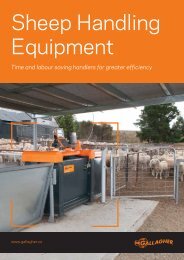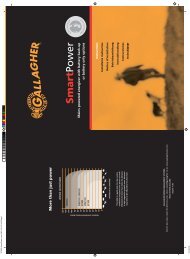information on how to tie Bayco - Gallagher Australia
information on how to tie Bayco - Gallagher Australia
information on how to tie Bayco - Gallagher Australia
Create successful ePaper yourself
Turn your PDF publications into a flip-book with our unique Google optimized e-Paper software.
<strong>Bayco</strong> Horse Fencing<br />
1) SAFETY. Always wear gloves and goggles when working and observe the<br />
necessary precauti<strong>on</strong>s when tensi<strong>on</strong>ing<br />
2) STEEL OR WOOD DROPPERS can be used with <strong>Bayco</strong>, <strong>how</strong>ever the <strong>Bayco</strong><br />
must be protected from coming in c<strong>on</strong>tact with the dropper. Use fastenings made<br />
from a flexible synthetic material eg. plastic electric fencing insula<strong>to</strong>rs. Droppers<br />
should be used in the same manner as when erecting metal wire fences. It should<br />
be noted that the more droppers that are utilised the more rigid and secure the<br />
fence becomes.<br />
3) DISPENSING. Open cart<strong>on</strong> and remove <strong>tie</strong>s from coil. Thread end of coil<br />
through large hole in centre of cart<strong>on</strong>. Close cart<strong>on</strong>. Dispense by pulling <strong>Bayco</strong><br />
through hole<br />
4) CORRECT METHOD FOR ATTACHMENT OF BAYCO FENCING TO<br />
POSTS.<br />
4.A) The fencing is wound three times around the post leaving 60cm in excess for<br />
knotting as per following instructi<strong>on</strong>s. Wedge screwdriver or similar spacer<br />
between the <strong>Bayco</strong> and the fence post <strong>to</strong> allow room <strong>to</strong> secure the loose end as per<br />
secti<strong>on</strong> c.<br />
A)<br />
4.B) The 60cm end piece is wound about five times around the fencing, keeping<br />
each turn close <strong>to</strong> the <strong>on</strong>e before.<br />
B)
<strong>Bayco</strong> Horse Fencing C<strong>on</strong>tinue<br />
4.C) Then wind five times back again by the same method as in B and the end<br />
piece is pushed through between the wound fencing and the end post <strong>to</strong> secure the<br />
knot. The screwdriver can then be removed. If required, a staple can be inserted<br />
around the loose end for further security.<br />
C)<br />
5) BAYCO FENCING SHOULD HAVE 3% EXTENSION.<br />
Normal smooth jaw wire strainers can be used for tensi<strong>on</strong>ing: <strong>how</strong>ever care<br />
should be taken <strong>to</strong> tensi<strong>on</strong> slowly. For every 100 metres of n<strong>on</strong>-tensi<strong>on</strong>ed fencing<br />
stretch out three metres of <strong>Bayco</strong> <strong>to</strong> obtain the required 3% extensi<strong>on</strong>. A simple<br />
method <strong>to</strong> gauge the tensi<strong>on</strong> you are applying is d<strong>on</strong>e by estimating the strain, eg.<br />
3% equals three metres over 100 metres. Simply pace this out against the <strong>Bayco</strong>.<br />
Mark the <strong>Bayco</strong> with a soft pen or tape or peg and then proceed <strong>to</strong> tensi<strong>on</strong> the<br />
product up <strong>to</strong> this mark.<br />
Product Code: A6061<br />
Warranty: 10 years<br />
For more <str<strong>on</strong>g>informati<strong>on</strong></str<strong>on</strong>g> c<strong>on</strong>tact <strong>Gallagher</strong> <strong>Australia</strong>:<br />
Melbourne <strong>on</strong> (03) 93087722 Sydney (02) 96841777 www.gallagher.com.au





